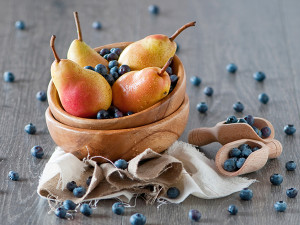Pears: The Healthy Sweet Treat
in The Too Busy to Diet Blog on September 26, 2015
 The Centers for Disease Control (CDC) aims to have at least 75% of the U.S. population consuming two or more portions of fruits daily, and three or more servings of vegetables. If the target goals are met, 5-9 fruits and vegetables should be consumed daily.
The Centers for Disease Control (CDC) aims to have at least 75% of the U.S. population consuming two or more portions of fruits daily, and three or more servings of vegetables. If the target goals are met, 5-9 fruits and vegetables should be consumed daily.
In 2013, CDC found that 13.1% of people questioned were meeting the goal of fruit consumption and 8.9% were meeting the goal of vegetable consumption. Consuming pears is a great way to meet the fruit consumption goals this fall.
Pears are members of the rose family of plants. The many different varieties of pears commonly found in U.S. all belong to the same category known as the European Pear. These pears typically have a rounded body that tapers into a neck of various lengths. Pears are found in a variety of colors, including many different shades of green, red, yellow, gold, and brown. Many varieties fail to change color as they ripen. Bartlett pears are the best known of the pear varieties in the U.S. and are the most common variety found in cans. Comice pears are round, short pears with green or red coloring, or sometimes almost completely red with especially soft or juicy flesh. Red Bartlett pears are very much like its yellow or green counterpart, except with an all-round bright red skin. They sometimes feature light vertical striping, like Red Anjou, rich in powerful antioxidants. Seckel pears are the smallest of the community eaten pears, usually yellow or green or olive green in color, and mixed with broad patches of red.
On a worldwide basis, China has become the world’s largest grower of pears. Out of 21 million tons produced worldwide, China now produces about 15.5 million tons, or nearly three quarters of the world total. Of the remaining 5.5 million tons, another 2.7 million tons come from Europe, 1.1 million tons from Argentina and Chile, 0.8 million tons from the United States, and smaller amounts from New Zealand, South Korea, and other countries. In the United States, the state of Washington is by far the largest grower of pears, accounting for about half of all United States produced pears. California and Oregon follow next, with significant commercial production also occurring in New York and Pennsylvania.
Pears are a great fruit source of dietary fiber. Fiber helps reduces the development of type 2 diabetes, as well as risk from heart disease. In the case of heart disease, recent research has shown that pear fibers are able to bind together with bile acids and decrease the synthesis of cholesterol. Pear fiber also helps reduce cancer risk. Fiber in the pears can decrease the risk of colorectal and gastric cancer because the fiber lowers bile production. Esophageal cancer risk is also lowered by higher fiber intake that can be supported by consuming pears. Pears are easily digestible and have a low risk for food allergy. They are a good fruit choice due to its numerous health benefits and its sweet and rich taste.
http://www.eatright.org/resource/food/planning-and-prep/recipes/pear-berry-breakfast-crisp-recipe
http://www.eatright.org/resource/food/planning-and-prep/recipes/honey-dijon-vinaigrette-with-arugula-pear-and-walnut-salad-recipe
http://www.diabeticlivingonline.com/recipe/muffins/ginger-pear-muffins
Written by Tracy Williams
Tracy is a graduate of Dominican University with a degree in Nutrition & Dietetics
Buy the Too Busy to Diet book
Get your copy of the definitive diet reference guide and healthy eating book today. Stop reading those misleading fad diet books and read an easy to follow book on how to lose weight and keep it off from actual Registered Dietitians.

Recent Posts
- Barbeque Turkey Meatloaf
- Pescado a la Veracruzana
- Juicy Pork Chops
- Rotasserie Chicken Casserole
- Grilled Salmon & Blueberry Salad